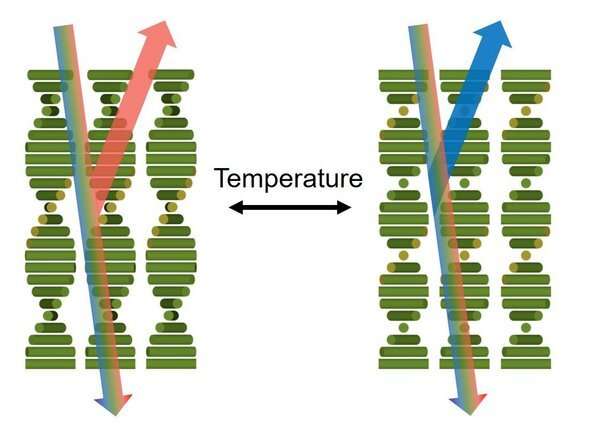Color-changing coatings triggered by temperature changes

The changing of color can influence our perception of objects, be used to warn us against dangers or hazards, or help to conserve energy. Ph.D. candidate Weixin Zhang has developed organic "photonic" coatings that change colors with changing temperatures. Robust smart coatings were fabricated that can be easily processed and show a rapid color-changing response to temperature changes. These coatings are promising for a variety of applications such as heat regulating "smart" windows or even interactive artworks. Zhang defended this thesis at the department of Chemical Engineering and Chemistry on September 1.
Chameleon inspiration
Adaptive color-changing materials are interesting for visual recognition, expression of signals, and aesthetics. A good example from the natural world of color-adaption can be seen with the chameleon, which is a species that can change its skin colors to camouflage and regulate body temperature.
For his research, Zhang took inspiration from the chameleon to develop synthetic color-changing coatings that are responsive to different wavelengths. The first coating is temperature responsive at visible wavelengths (between 400 and 700 nm), while the second is an infrared (between 700 and 2,500 nm) reflective photonic coating.
The infrared coating could be used to regulate infrared light reflection in a window, which can in turn be used to help with indoor heat management. Significantly, this can be achieved without affecting the view through the window given that the invisible "structural colors" selectively reflect infrared wavelengths.
More on photonic materials
Zhang's coatings are fundamentally based on photonic materials, which have a periodic nanostructure that facilitates the reflection of specific wavelengths of light. As a result, the structure will then appear to have the reflected color.
Importantly, photonic materials have key advantages over color-altering materials such as absorption-based dyes. First, the color exhibited by a photonic material can be precisely tuned by modifying the nanostructure of the material. This can be achieved with minimal changes to the chemical composition of the material itself and makes it quite easy to tune the color of the nanostructure over a wide range of wavelengths.
Second, given that the photonic materials only reflect light at specific wavelengths, it's possible to produce materials that are transparent to visible light, but will reflect longer wavelengths such as infrared radiation.
Coating materials
Over the course of Zhang's research, a variety of adaptive temperature-responsive photonic coatings were fabricated. Siloxane-based cholesteric liquid crystal polymers were synthesized and then coated onto substrates using a simple film applicator. The resulting photonic films show fast and fully reversible color responses to environmental temperature changes. The coatings can be scaled up, which makes them interesting for use as temperature indicators, interactive artworks, and as infrared-selective reflective windows for homes and other buildings.
Provided by Eindhoven University of Technology





















